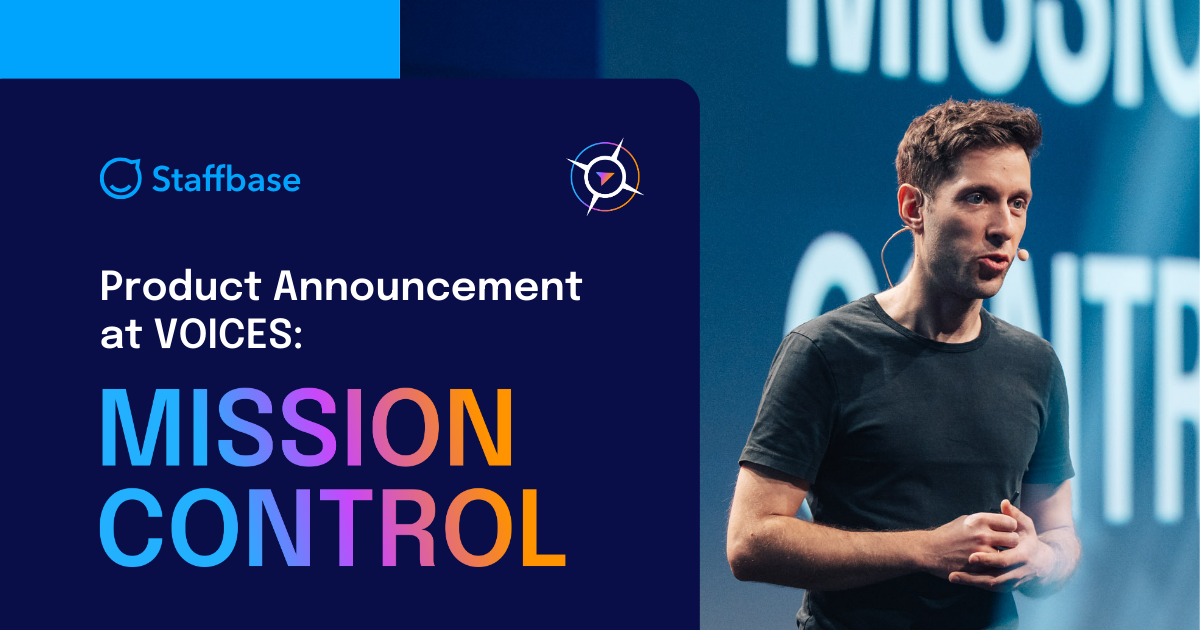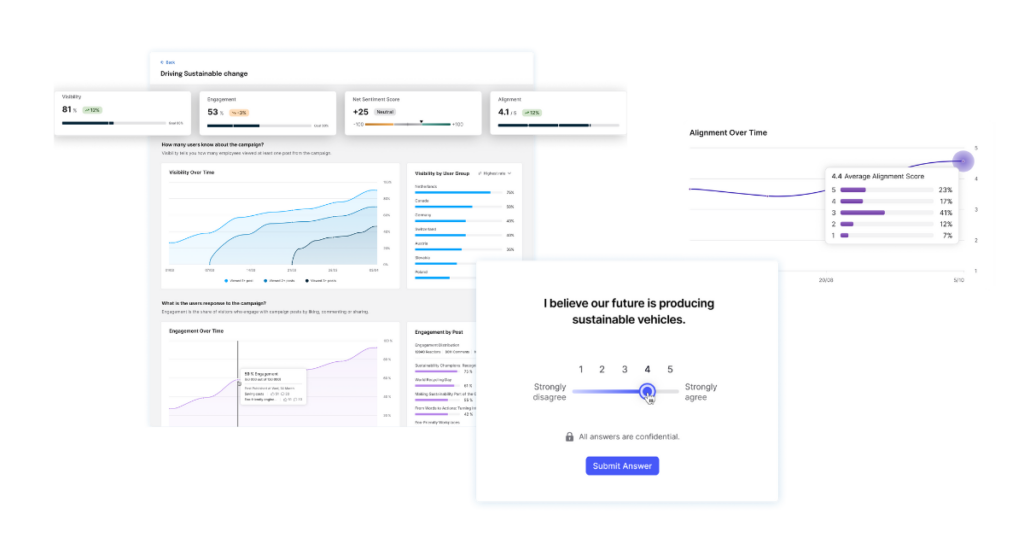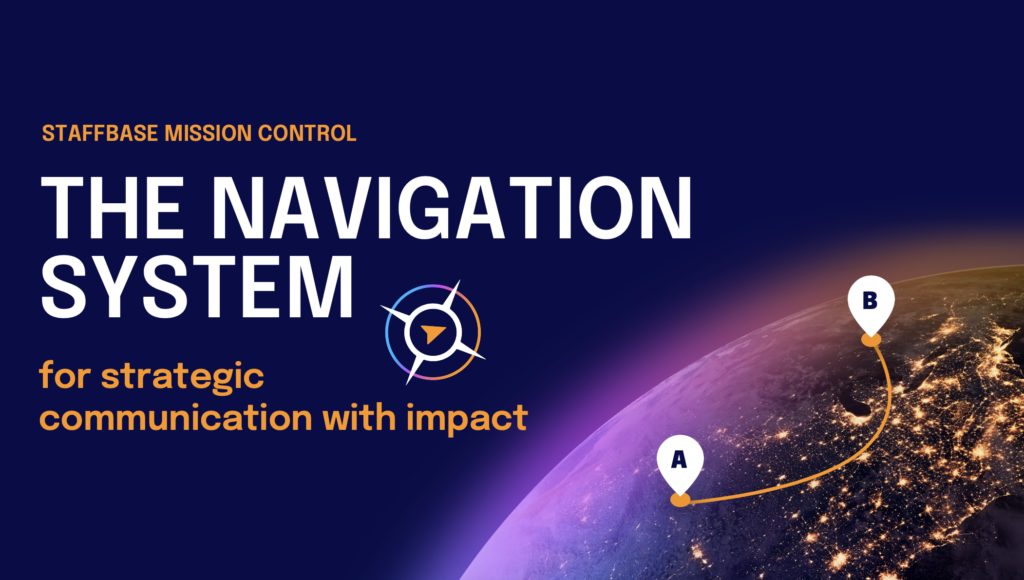Mission Control: The Navigation System for Communication
Staffbase CEO Martin Böhringer Introduces New Product at VOICES 2024 in Berlin

Remember those long vacation drives before GPS or smartphones were a thing? Handwritten directions, a bulky road atlas in the glove box, a highlighter, and sticky notes. Traffic updates on the radio. Know-it-all copilots. Deciphering foreign road signs.

Sure, we eventually got where we were going. But let’s not be blinded by nostalgia. It wasn’t exactly a cake walk. Route planning was a mess of maps and guesswork. And once we were on the road we only knew roughly where we were and how long it would take to reach our next stop. When the inevitable detour sign would appear, all our meticulous planning was rendered useless. Course correction at the touch of a button? Science fiction.
Today, only the purists and adventurers among us would likely travel without GPS or a smartphone.
So, why does the work of communicators still feel like navigating with compasses and maps instead of a stress-free road trip guided by all of the digital assistance systems none of us today can even think of living without?
For communicators, it’s time for a modern navigation system.
Corporate communications are largely digitized today. Handwritten editorial plans and piles of printed content for colleagues to proofread thankfully (in most cases) belong to the past.
Yet, despite all this digitization, there’s often a missing piece: a central navigation system. A tool that helps you plan your route and execute it, all the while warning you of potential hazards, providing course corrections, and a detailed analysis of your journey.
Let’s set aside the travel metaphors and look at the specific challenges communicators face today:
Intransparent topic, campaign, and editorial planning
Constant change and complexity
Difficulty maintaining focus and consistency
Departmental and channel silos (lack of a “single source of truth”)
Planning and publishing not possible through the same platform
Lack of collaboration and consistent approval processes
Communication seen only as a publishing channel
Focus on output rather than outcome
Underestimation of the strategic relevance and ROI of communication
Inability to prove the actual impact of communication
These challenges repeatedly arise in conversations with communication professionals worldwide. Therefore, we set out to find a solution. Now, our CEO Martin Böhringer announced this solution on the stage of VOICES 2024 in Berlin for the first time.
The Future of Strategic Communication: Generating and Proving Business Impact
We believe that communication is one of the greatest drivers of business success. Inspired teams achieve more. And inspiration begins with communication. With a vision and a narrative that unites employees of every type and motivates them to work towards a common goal.
However, this business impact of communication is difficult to control and even harder to prove. Until now. Because we’ve developed a navigation system for corporate communications that keeps the entire organization on course through communication: Staffbase Mission Control.
Plan, create, measure — the functionalities of Mission Control
Let’s take a closer look at the core functions of Mission Control: planning, co-creation, and measurement.
 Sarah Manes, Senior Director of Product, presented the features and use cases of Staffbase Mission Control at VOICES 2024 in Berlin. We have summarized the most important points for you.
Sarah Manes, Senior Director of Product, presented the features and use cases of Staffbase Mission Control at VOICES 2024 in Berlin. We have summarized the most important points for you.
Strategic planning of topics, campaigns, and content

It’s time to say goodbye to the 25 different documents, lists, boards, and tools where you currently plan communication measures to reach your diverse target groups. In Mission Control, you’ll find a central communication map for all topics and channels.
These plans can be linked to strategic goals to ensure results-oriented communication. The focus is on overarching topics, as opposed to isolated individual channels.
Different views allow you to keep track of the progress and responsibilities of strategic topics, a campaign, or a specific piece of content. This transparency is a crucial success factor for integrated communication.
Mission Control thus becomes the “Single Source of Truth” for your communication planning.
Co-creation: Collaboratively creating content

Communicators repeatedly tell us that collaboration — whether internally or across departmental and site boundaries — is difficult to coordinate. Briefings, content creation, editing, and approvals happen across multiple tools and channels. Unified, reliable workflows? Good luck with that. Until now.
Mission Control focuses on co-creation, i.e. the collaborative creation of content. Multi-channel briefings ensure that strategic guidelines are considered in the operational content creation for all channels and target groups. This keeps messages consistent and engaging.
In a Kanban board, you manage your own tasks and create tasks for your colleagues. Additionally, Mission Control has an approval workflow that streamlines the approval process for your email, intranet article, newsletter, social post, etc.
Then, you can publish your content directly from the Staffbase Studio to both internal and external channels. That’s right! Through the Public API, even custom channels, i.e. channels outside of the major platforms, can be connected.
Measuring impact with results-oriented analyses
Now that you’ve planned, created, and published your content, it’s time to check if it had the desired effect. We call this functionality: Smart Impact.

In Mission Control, you can create campaigns with goal definitions and KPIs. You measure quantitative performance metrics like visibility and interactions. These data give you important initial indications of the reach your content achieved.

However, what’s special about Smart Impact are the qualitative analyses, which allow you to measure approval of campaigns and messages or the mood among employees.
You can easily add these Alignment Surveys to an intranet article or other content. Initial tests with pilot customers have shown that content with these surveys received up to 35 times more engagement.
The rule here is: Outcome is more important than output. Based on the statistics, you will receive recommendations on how to better reach your target audience. All channel performance data and feedback from the target audience and community are included in the analysis.
With Mission Control and Smart Impact, communicators can finally demonstrate the direct influence of their communication on business metrics such as revenue, employee engagement, and brand perception.
Pilot customers confirm the strategic value of Mission Control
Some Staffbase customers have already been testing Mission Control. From planning to creation to measuring success, they were able to effectively implement their communication strategies and prove the impact of their messages.
Mission Control really proved the value of our strategic initiative during a difficult time for the company.”
Manager, Communication Campaigns, Walgreens
These customers have shared their valuable experiences and insights with us, allowing us to improve and further develop Mission Control. We’re now expanding the testing phase to a beta program for all interested Staffbase customers.
Sign up for the beta program
Good news for all Staffbase customers: You can register for a beta program. From May 16 to October 31, 2024, you will have free access to the first beta features of Mission Control. Further updates will be released with each Quarterly Release.
What’s next and when can you use Mission Control?
Many basic functions of Mission Control are already complete, while others are currently being developed.
Staffbase customers will have the opportunity to sign up for the beta program starting May 16, 2024.
In Q4, Mission Control will be officially released with expanded functionality.
Like all our products, we will continuously develop Mission Control and welcome your feedback to create the greatest possible value for your work.
So let us know: What do you think of Mission Control, the navigation system for strategic corporate communication?










